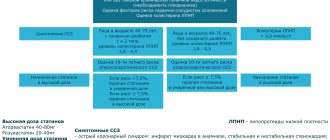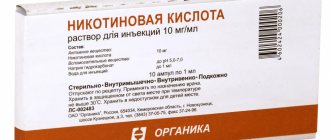Ipokol, Kolestyramine, Questran, Cholestan, Divistyramine are not analogues. These names of medications are synonymous with each other and with the drug Cholestyramine, which belong to a single pharmacological group: Bile acid sequestrants, which reduce lipid levels in the blood and also contribute to the rapid removal of cholesterol from the intestines, have no relationship.
Cholestyramine - for preparing a suspension
Pharmacodynamics and pharmacokinetics
The mechanism of action of Cholestyramine is based on its ability to bind bile acids , thus forming insoluble chelate complexes , which are then excreted naturally in the feces. The substance can also reduce the absorption capacity of cholesterol and other fatty acids and stimulate the synthesis of bile acids in liver tissue (feedback mechanism).
Preparations based on this component significantly reduce the level of cholesterol and low-density lipoproteins in the blood. During enterohepatic circulation, about 98% of bile acids are reabsorbed into the intestine and enter the liver, then again excreted in the bile. The liver is forced to expend cholesterol in order to synthesize additional bile acids . Thus, excess cholesterol and LDL .
In patients suffering from type 2 hyperlipoproteinemia , the drug significantly reduces cholesterol and lipoprotein . In case of partial obstruction of the biliary tract, the substance reduces the content of bile acids , prevents their deposition in the skin, and relieves itching.
To achieve the desired therapeutic effect, long-term systematic treatment is usually required. It is recommended to take the medicine for at least 30 days. During drug therapy, it is necessary to monitor the content of folic acid in the blood and red blood cells , monitor digestion and blood clotting.
The absorption capacity of Cholestyramine strongly depends on the pH of the medium. The product is most effective at a neutral pH. In this regard, the medicine is somewhat inferior to other modern analogues.
Cholestyramine is not absorbed in the intestine and therefore does not have systemic toxic effects on the body. The half-life of the substance is about one hour.
Clinical researches
Reducing cholesterol is the main task of Cholestyramine
Cholestyramine is prescribed as an adjuvant form of therapy, complementing diet accompanied by exercise. Its focus is on reducing cholesterol levels in patients with signs of the primary stage of hypertriglyceridemia or hypercholesterolemia, excluding the pathologically dominant stage of the latter.
The drug is also prescribed to patients at risk with myocardial infarction and atherosclerotic lesions of the coronary arteries. The use of Cholestyramine may also be indicated as a symptomatic treatment for patients with:
Indications for use
The drug is prescribed:
- with hyperlipoproteinemia type 2, especially type 2a;
- for the prevention of complications in atherosclerosis, angina pectoris, myocardial infarction, coronary heart disease , if other methods remain ineffective;
- to relieve itching with partial obstruction of the biliary tract .
Side effects
Cholestyramine-based drugs have a number of side effects:
- constipation , pain in the epigastric region;
- flatulence;
- vomiting and nausea;
- diarrhea and heartburn ;
- indigestion;
- anorexia , pancreatitis ;
- skin rashes, irritation and itching;
- increased sexual activity and desire.
With long-term treatment with the drug, the following may develop:
- bleeding disorders, bleeding in the stomach and duodenum;
- hyperchloremic acidosis;
- hemorrhoidal bleeding;
- gastrointestinal obstruction .
Side effects
- From the gastrointestinal tract - nausea, less often vomiting, diarrhea, or constipation, more often - flatulence.
- From the nervous system - insomnia, headache, anxiety, clouding of consciousness, extremely rarely - fainting.
- On the part of the skin - irritation, itching, rash, urticaria.
- From the excretory system - a change in the smell of urine, extremely rarely - darkening of the stool.
In case of significant side effects, the dose of the drug should be reduced. The main conclusion from the recommendations for the use of Cholestyramine is that there is a serious need to strictly follow the recommendations of the attending physician. Have constant contact with him and immediately report all changes occurring in your own body.
Cholesterol. Myths and deception. Why is cholesterol necessary? Watch the video:
Cholestyramine, instructions for use (Method and dosage)
Most often, the substance is produced in the form of a powder for the preparation of a suspension or tablets.
The dosage regimen and duration of treatment are determined by the attending physician.
Cholestyramine tablets and powder are taken orally before meals.
The powder can be mixed with water, cream or juice. The prepared suspension must be mixed well and drunk 10 minutes after preparation.
The dosage is selected individually, depending on the patient’s age and type of disease. As a rule, for adults the daily dosage is from 4 to 24 grams of the active substance, distributed over 2,3 or 4 doses.
Composition of the drug
- The active ingredient is Cholestyramine resin.
- The drug is produced in the form of a dosed powder, packaged in 4 g bags of polyethylene.
- One package contains 500 g of the drug.
- Sucrose, dehydrated citric acid, various yellow food colors, and flavorings are used as excipients.
- According to the instructions, the powder is diluted in water. The resulting suspension is taken orally and has a sweet citrus taste.
Interaction
The drug reduces the diuretic effect of taking furosemide .
Cholestyramine reduces the absorption of raloxifene and sulindac (even when a three-hour interval is observed between doses).
When taking medication with levothyroxine or other thyroid hormones, their effectiveness and plasma levels are reduced.
The combination of this drug with ferrous sulfate or phenylbutazone leads to a decrease in plasma concentrations of both drugs.
Cholestyramine reduces the absorption capacity of hydrochlorothiazide and its diuretic effect.
The combined use of this substance and vancomycin leads to loss of effectiveness of vancomycin .
When taking the drug and amiodarone , the concentration of the latter in the blood can increase significantly.
The combination of Cholestyramine with tricyclic antidepressants such as imipramine, desipramine, amitriptyline, nortriptyline can lead to a decrease in their plasma concentrations.
The substance may enhance the effectiveness of acarbose .
Cholestyramine reduces the effectiveness of sodium valproate , anticoagulants ( warfarin, dicumarol, phenprocoumon, ethylbiscoumacetate ), glipizide and hydrocortisone .
When combining the drug with digoxin , if a gap of 1.5 hours is observed between doses of the drugs, Cholestyramine does not affect the plasma concentration and effectiveness of the drug.
It is not recommended to combine the medicine with ibuprofen and diclofenac . This may lead to a decrease in the absorption capacity of NSAIDs .
The medicine reduces the effectiveness of loperamide, methotrexate, metronidazole, paracetamol .
The combination of the substance with piroxicam, tenoxicam and meloxicam accelerates the elimination of drugs from the body.
Concomitant use of the drug and spironolactone can lead to the development of hypochloremic alkalosis .
Cholestyramine (cholestyramine)
Cholestyramine
or
cholestyramine
(eng.
cholestyramine
or
colestyramine
) is an ion exchange resin that binds bile acids in the intestines, an adsorbent. Currently, there are no drugs containing cholestyramine approved for use in Russia.
Cholestyramine is a chemical substance
Cholestyramine is a copolymer of styrene and divinylbenzene containing quaternary ammonium groups. The gross formula of cholestyramine is [C22H29NO]n.
Cholestyramine is the international nonproprietary name of the drug
Cholestyramine is the international nonproprietary name (INN) of the drug.
According to the pharmacological index, cholestyramine belongs to the group “Bile acid sequestrants”, according to ATC - to the group “Lipide-lowering drugs” and has the code C10AC01. The mechanism of action of cholestyramine is the binding of cholesterol and bile acids, which are synthesized from cholesterol in the liver. During the enterohepatic circulation, approximately 97% of bile acids are reabsorbed into the intestines and enter the liver through the portal vein system, and are then excreted again in the bile. Due to the binding of bile acids by cholestyramine, the liver synthesizes additional volumes of bile acids, using up cholesterol and thus reducing its total amount in the body. Cholestyramine helps lower blood cholesterol, especially to reduce elevated levels of low-density lipoprotein - the so-called "bad" cholesterol (LDL). High cholesterol levels are associated with an increased risk of heart disease and atherosclerosis (clogged arteries). Cholestyramine is also used to treat itching resulting from partially blocked bile ducts and as adjunctive therapy in patients on a special diet designed to reduce elevated cholesterol levels. As an adsorbent, cholestyramine is inferior to smecta: the adsorbing ability of smecta relative to bile salts does not depend on the level of the solution, while cholestyramine adsorbed better in a neutral environment and worse in an acidic environment. Lysolecithin was more intensively adsorbed by smecta (90%) than by cholestyramine (70%). The intensity of adsorption does not depend on pH and contact time (Storonova O.A. et al.).
Cholestyramine has been used for a long time as a lipid-lowering drug, but its lower effectiveness than drugs from the statin group, as well as poor patient tolerance, led to a significant reduction in its use, and in a number of countries, including Russia, to the cessation of its use altogether.
How to take cholestyramine and dosage
Cholestyramine in most drugs is a powder packaged in a dosage of 4 g.
Initially, cholestyramine is taken before meals, orally, once or twice a day, then switches to a three times a day regimen. In general, dosage should be individualized and based on clinical response and patient tolerance of side effects and range from 8 to 36 g per day in 2, 3 or 4 divided doses.
Cholestyramine is not absorbed in the intestine and therefore does not cause systemic toxic effects. Due to the absorption of bile acids and digestive enzymes, cholestyramine can cause side effects such as constipation, flatulence, and heaviness in the epigastric region.
The World Gastroenterology Organization emphasizes that cholestyramine can cause constipation.
Use of cholestyramine during pregnancy and breastfeeding
According to Russian requirements, cholestyramine therapy is discontinued during pregnancy.
Cholestyramine should also not be taken while breastfeeding. In the US, the FDA has assigned cholestyramine a fetal risk category of C.
Publications for healthcare professionals regarding the use of cholestyramine
- Maev I.V., Gulenchenko Yu.S., Andreev D.N., Kazyulin A.N., Dicheva D.T. Duodenogastroesophageal reflux: clinical significance and approaches to therapy // CONSIUUM MEDICUM. 2014. VOL. 16. No. 8. pp. 5–8.
- Storonova O.A., Trukhmanov A.S., Dzhakhaya N.L., Ivashkin V.T. Violations of esophageal clearance in gastroesophageal reflux disease and the possibility of their correction // RZHGGK. 2012. T. XXII. No. 2. pp. 14–21.
- Uspensky Yu.P., Fominykh Yu.A., Gnutov A.A. Duodenogastroesophageal reflux: current state of the problem. Medical alphabet. 2020; (37): 11–16.
Trade names of drugs with the active ingredient cholestyramine
Currently, there are no bile acid sequestrants approved for use in Russia, including those with the active ingredient cholestyramine.
Previously, Questran was registered. The following brands and generics of cholestyramine are registered in the United States: Cholestyramine Light, Prevalite, Prevalite Packets, Questran, Questran Light, Questran Light Packets, Questran Packets, Locholest, Locholest Light.
Cholestyramine has contraindications, side effects and application features; consultation with a specialist is necessary.
Back to section


